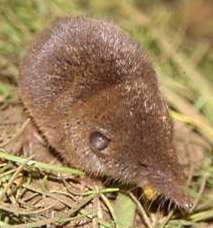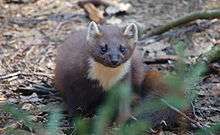List of mammals of Sardinia

This is a list of the mammal species recorded in Sardinia, Italy.[1]
The following tags are used to highlight each species' conservation status as assessed by the IUCN.
| EX | Extinct | No reasonable doubt that the last individual has died. |
| EW | Extinct in the wild | Known only to survive in captivity or as a naturalized populations well outside its previous range. |
| CR | Critically endangered | The species is in imminent risk of extinction in the wild. |
| EN | Endangered | The species is facing an extremely high risk of extinction in the wild. |
| VU | Vulnerable | The species is facing a high risk of extinction in the wild. |
| NT | Near threatened | The species does not meet any of the criteria that would categorise it as risking extinction but it is likely to do so in the future. |
| LC | Least concern | There are no current identifiable risks to the species. |
| DD | Data deficient | There is inadequate information to make an assessment of the risks to this species. |
Some species were assessed using an earlier set of criteria. Species assessed using this system have the following instead of near threatened and least concern categories:
| LR/cd | Lower risk/conservation dependent | Species which were the focus of conservation programmes and may have moved into a higher risk category if that programme was discontinued. |
| LR/nt | Lower risk/near threatened | Species which are close to being classified as vulnerable but are not the subject of conservation programmes. |
| LR/lc | Lower risk/least concern | Species for which there are no identifiable risks. |
Subclass: Theria
Infraclass: Eutheria
Order: Rodentia (rodents)
Rodents make up the largest order of mammals, with over 40 percent of mammalian species. They have two incisors in the upper and lower jaw which grow continually and must be keep short by gnawing. Most rodents are small though the capybara can weigh up to 45 kg (100 lb).
- Suborder: Sciuromorpha
- Family: Gliridae (dormice)
- Subfamily: Glirinae
- Genus: Glis
- Edible dormouse, Glis glis LC
- Genus: Glis
- Subfamily: Leithiinae
- Genus: Eliomys
- Garden dormouse, Eliomys quercinus NT
- Genus: Eliomys
- Subfamily: Glirinae
- Family: Gliridae (dormice)
- Suborder: Myomorpha
- Family: Cricetidae (hamsters and voles)
- Subfamily: Cricetinae
- Genus: Tyrrhenicola
- Corsican-Sardinian vole, Tyrrhenicola henseli EX
- Genus: Tyrrhenicola
- Subfamily: Cricetinae
- Family: Muridae (mice and rats)
- Subfamily: Murinae
- Genus: Apodemus
- Wood mouse, Apodemus sylvaticus LC
- Genus: Mus
- House mouse, Mus musculus LC
- Genus: Rattus
- Genus: Apodemus
- Subfamily: Murinae
- Family: Cricetidae (hamsters and voles)
Order: Lagomorpha (lagomorphs)
The lagomorphs comprise two families, Leporidae (hares and rabbits), and Ochotonidae (pikas). Though they can resemble rodents, and were classified as a superfamily in that order until the early 20th century, they have since been considered a separate order. They differ from rodents in a number of physical characteristics, such as having four incisors in the upper jaw rather than two.
- Family: Leporidae (rabbits, hares)
- Genus: Oryctolagus
- European rabbit, Oryctolagus cuniculus LR/lc
- Genus: Lepus
- Cape hare, Lepus capensis LR/lc
- Genus: Oryctolagus
- Family: Prolagidae (European pikas)
- Genus: Prolagus
- Sardinian pika, Prolagus sardus EX
- Genus: Prolagus
Order: Erinaceomorpha (hedgehogs and gymnures)
The order Erinaceomorpha contains a single family, Erinaceidae, which comprise the hedgehogs and gymnures. The hedgehogs are easily recognised by their spines while gymnures look more like large rats.
- Family: Erinaceidae (hedgehogs)
- Subfamily: Erinaceinae
- Genus: Erinaceus
- European hedgehog, Erinaceus europaeus LC
- Genus: Erinaceus
- Subfamily: Erinaceinae
Order: Soricomorpha (shrews, moles, and solenodons)
The "shrew-forms" are insectivorous mammals. The shrews and solenodons closely resemble mice while the moles are stout bodied burrowers.
- Family: Soricidae (shrews)
- Subfamily: Crocidurinae
- Genus: Crocidura
- North African white-toothed shrew, Crocidura ichnusae LC
- Genus: Suncus
- Etruscan shrew, Suncus etruscus LC
- Genus: Crocidura
- Subfamily: Soricinae
- Genus: Nesiotites
- Sardinian shrew, Nesiotites similis EX
- Genus: Nesiotites
- Subfamily: Crocidurinae
Order: Chiroptera (bats)
The bats' most distinguishing feature is that their forelimbs are developed as wings, making them the only mammals in the world naturally capable of flight. Bat species account for about 20% of all mammals.
- Family: Miniopteridae (long-winged bats)
- Subfamily: Miniopterinae
- Genus: Miniopterus
- Subfamily: Miniopterinae
- Family: Molossidae (free-tailed bats)
- Subfamily: Molossinae
- Genus: Tadarida
- Subfamily: Molossinae
- Family: Rhinolophidae (horseshoe bats)
- Subfamily: Rhinolophinae
- Genus: Rhinolophus
- Subfamily: Rhinolophinae
- Family: Vespertilionidae (mouse-eared bats)
- Subfamily: Myotinae
- Genus: Myotis
- Subfamily: Verpertilioninae
- Genus: Barbastella
- Genus: Eptesicus
- Genus: Hypsugo
- Genus: Nyctalus
- Genus: Plecotus
- Genus: Pipistrellus
- Subfamily: Myotinae
Order: Cetacea (whales)
The order Cetacea includes whales, dolphins and porpoises. They are the mammals most fully adapted to aquatic life with a spindle-shaped nearly hairless body, protected by a thick layer of blubber, and forelimbs and tail modified to provide propulsion underwater.
- Suborder: Mysticeti
- Family: Balaenopteridae (rorquals)
- Genus: Balaenoptera
- Common minke whale, Balaenoptera acutorostrata LC
- Fin whale, Balaenoptera physalus EN
- Genus: Balaenoptera
- Family: Balaenopteridae (rorquals)
- Suborder: Odontoceti
- Family: Delphinidae (dolphins and pilot whales)
- Genus: Grampus
- Risso's dolphin, Grampus griseus LC
- Genus: Globicephala
- Long-finned pilot whale, Globicephala melas DD
- Genus: Orcinus
- Killer whale, Orcinus orca DD
- Genus: Grampus
- Family: Physeteridae (sperm whales)
- Genus: Physeter
- Sperm whale, Physeter macrocephalus VU
- Genus: Physeter
- Family: Ziphiidae (beaked whales)
- Genus: Mesoplodon
- Blainville's beaked whale, Mesoplodon densirostris DD
- Genus: Ziphius
- Cuvier's beaked whale, Ziphius cavirostris LC
- Genus: Mesoplodon
- Family: Delphinidae (dolphins and pilot whales)
Order: Carnivora (carnivorans)
There are over 260 species of carnivorans, the majority of which feed primarily on meat. They have a characteristic skull shape and dentition.
- Suborder: Feliformia
- Family: Felidae (cats)
- Genus: Felis
- African wildcat, Felis lybica LC
- Genus: Lynx
- Sardinian lynx, Lynx lynx sardiniae EX[2]
- Genus: Felis
- Family: Felidae (cats)
- Suborder: Caniformia
- Family: Canidae (dogs, foxes, wolves)
- Genus: Cynotherium
- Sardinian dhole, Cynotherium sardous EX[3]
- Genus: Vulpes
- Red fox, Vulpes vulpes LC
- Genus: Cynotherium
- Family: Mustelidae (weasels)
- Genus: Martes
- Pine marten, Martes martes LC
- Genus: Mustela
- Least weasel, Mustela nivalis LC
- Genus: Martes
- Family: Canidae (dogs, foxes, wolves)
Order: Artiodactyla (even-toed ungulates)
The even-toed ungulates are ungulates whose weight is borne about equally by the third and fourth toes, rather than mostly or entirely by the third as in perissodactyls. There are about 220 artiodactyl species, including many that are of great economic importance to humans.
- Family: Suidae (pigs)
- Family: Bovidae (cattle, antelope, sheep, goats)
- Family: Cervidae (deer)
- Subfamily: Cervinae
- Genus: Cervus
- Corsican red deer, Cervus elaphus corsicanus NT
- Genus: Dama
- Fallow deer, Dama dama LC
- Genus: Cervus
- Subfamily: Cervinae
See also
- List of chordate orders
- List of regional mammals lists
- List of prehistoric mammals
- Mammal classification
- New mammal species
Notes
- ↑ The taxonomy and naming of the individual species is based on those used in existing Wikipedia articles as of 9 January 2013 and supplemented by the common names and taxonomy from the IUCN where no Wikipedia article was available.
- ↑ Wozencraft, W. C. (2005). "Order Carnivora". In Wilson, D. E.; Reeder, D. M. Mammal Species of the World (3rd ed.). Johns Hopkins University Press. pp. 532–628
- ↑ Gippoliti, Spartaco & Amori, Giovanni (2006). "Ancient introductions of mammals in the Mediterranean Basin and their implications for conservation". Mammal Review 36 (1): 37–48.
References
- Aulagnier, S. et al. (2008) Guide des mammifères d'Europe, d'Afrique du Nord et de Moyen-Orient. Delachaux et Niestlé, Paris
- Shirihai, H. & Jarrett, B. (2006) Whales, dolphins and seals: A field guide to the marine mammals of the world. A & C Black, London
| ||||||||||||||||||

.jpg)




_-British_Wildlife_Centre-8.jpg)

